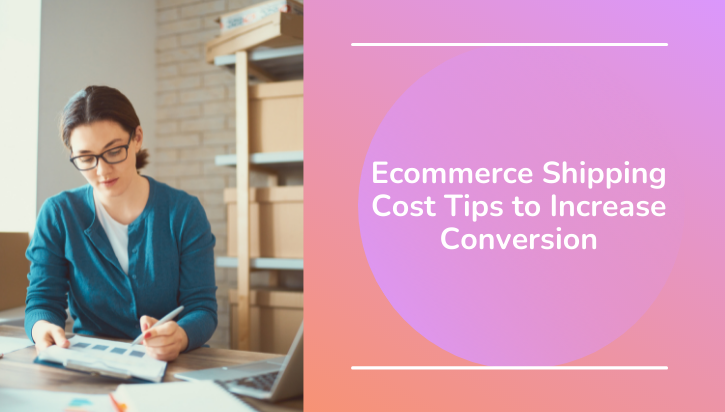
8 Ecommerce Shipping Cost Tips to Increase Conversion
As the pandemic rages on, more people are shifting to ecommerce from in-store shopping. A survey by Shopify found that around half of consumers feel uncomfortable going to physical stores due to the fear of being infected.
Even though ecommerce is booming, converting customers is more challenging than ever before. Some of the major triggers of abandonment are inconvenient shipping options, long delivery times and unavailability of stock, as 57% of Aussie shoppers would agree. Moreover, around 50% of US shoppers identify high shipping costs, inflated taxes and steep fees as the primary causes. As you can’t do much about taxes and fees, optimising your shipping and delivery is of utmost importance.
Whether you are selling locally or across borders, having a well thought out shipping strategy is vital for converting customers and nudging them in the direction of repeat purchases. In addition, a well-optimized shipping strategy could decrease cart abandonment, increase average order value and most importantly, ramp up customer conversion.
This article is our attempt to help ecommerce business owners formulate and execute shipping strategies that could potentially boost sales and consistently intrigue customers to keep coming back for more. So without further ado, let’s dive right in.
1. Offer free shipping
Who doesn’t love free stuff? And when you offer free shipping, the chances of locking in that sale goes higher as 90% of consumers find free shipping as the most intriguing incentive for shopping online.
Some of you might be asking, ‘How do I stay profitable if I offer free shipping?’
Offering free shipping doesn’t mean you have to cut into your bottom line and take a philanthropic approach to please your customers. Technically, you are factoring the shipping charges into the price of your products.
This strategy is not suitable for low margin products. For example, if you offer free shipping worth 50$ with a product worth 10$, you will have to increase the product’s price to 60$ (to be in profit), which will deteriorate your sales and create severe trust issues among customers.
High-ticket items, on the other hand, are perfect for incorporating unconditional free shipping. Nobody will bat an eye if you offer 50$ worth of free shipping with a product that’s worth 500$ or 1000$, for instance.
2. Know your profit margins, pricing strategies and average order value
To incorporate free shipping profitably, look into your profit margins and pricing strategies and compare them with what your competitors are offering. Once you get hold of the associated numbers and add the shipping cost for respective products, you will get a solid idea about the price you can charge feasibly without losing money or upsetting customers.
Testing conditional free-shipping (that influences customers to reach a minimum threshold) and observing how your customers respond to them could also give you valuable insight. Knowing the average order value is crucial in this regard. For example, the average customer orders 75$ worth of products. Therefore, if you offer them free shipping on the purchase of 90$ or 100$ worth of products, they will more likely keep adding items to the cart as 93% of shoppers will keep adding items to their cart to qualify for free shipping.
3. Optimise your packaging solutions
If you want to reduce the shipping costs even more, optimise the packaging. As weight plays a significant role in determining the shipping charges, reducing bits off your packaging solutions could add up and save you a lot of money along the line.
However, going overboard and sacrificing the integrity of the packaging could damage your products in transit. The general rule of thumb is to use heavy packaging material (like cardboard and styrofoam) for delicate items. For items like clothing, soft toys, pillows, etc. (that are not easily damaged), use lightweight packagings like corrugated envelopes that come in different shapes and sizes.
Using free packaging provided by the carriers could be another solution, as long as they provide enough protection.
4. Offer flat rates
Flat rate shipping eliminates the need for weighing your packages, calculating distances, and determining delivery times, making the process convenient for both you and the shoppers. However, this strategy might require a bit more preparation than the ones we have already mentioned.
To begin with, you need to determine the average cost of shipping a package. Then, make sure you don’t undercharge or overcharge your customers drastically. Once you reach that magic number, the costs will be slightly under or over within tolerable margins. Fear not; the deficiencies (if any) will balance out as you go.
On the one hand, flat rate shipping encourages large orders, as small orders might not provide enough value. But, on the other hand, it might discourage small orders, which can often lead to abandonment. Hence, it is essential to determine if a flat rate works for your business, depending on purchasing patterns of your customers and the products you sell.
5. Consider offering table rates
Table rates are customised conditional rates based on sizes and weights, the number of products purchased, destinations, order totals, and anything you find relevant. This strategy is particularly suitable for businesses that sell a wide range of products over a large area, local and international.
Here are a few examples that could help you get on track:
- Offer free shipping on products worth 200$ or above
- Ship products weighing 10 pounds or less for 15$
- For products weighing above 10 pounds, offer 50$ shipping.
- If the destination is near (within a particular area), offer flat rate shipping of 10$.
As these are heavily customisable, your creativity will determine how well you execute table rates and intrigue customers to purchase more products. But, making the rates confusing and complicated could turn off customers and eventually jeopardise sales.
6. Provide live rates
In this strategy, you offer real-time shipping rates based on the exact prices the carriers charge. The costs vary depending on weights, sizes, distances, and shipping durations. One of the advantages is you can set any price you want for the products. Setting competitive prices will work in your favour.
On the other hand, your shipping costs won’t fluctuate as long as the carriers don’t change their rates. And when customers can cross-check the prices in real-time, they will be more trusting towards you. So along with providing a good value, you will also be enhancing the customer experience.
On the customers’ end, when they can choose from a plethora of options with varying prices, they might be willing to select economic options, minimising the need for free shipping. In addition, a sense of empowerment is also instilled among customers when they can make a significant decision in the purchasing process.
7. Negotiate your rates with potential carriers
Although you can negotiate your rates with potential carriers for all the products in-store, the method is most suitable for oversized and heavy items, for which you simply can’t or don’t want to offer free shipping.
Shipping costs for heavy products can add up to a lot. And if the cost exceeds the tolerable limit, customers might jump to a competitor without a second thought. In such cases, it is recommended that you negotiate your rates with multiple carriers and choose the ones that provide the best value and discounts.
8. Try combinations of multiple shipping options
It is entirely normal if standalone strategies do not induce expected outcomes as every business operates under different variables. Such circumstances call for mixing and matching multiple methods to find the best fit for your business.
Shipping strategy best practices
Here are some additional points to keep in mind to create a successful shipping strategy.
- Whichever strategy you choose to incorporate, the costs must be evident at checkout. Any grey area could question your credibility and make it more difficult to acquire customers.
- Being transparent about the expected delivery date is also crucial. If you exaggerate durations and cannot meet them, the customers will be less likely to make repeat purchases.
- It is also wise to keep customers updated with the real-time progress of shipments. Using email confirmations with the completion of each step will help put customers at ease.
- Respond promptly to customer queries. Facilitating a two-way communication channel between the carrier and the customer could help in this regard.
To sum up, free shipping is most appropriate when you can successfully incorporate the charges to the price of your products without getting yourself into a competitive disadvantage. Flat rate shipping will work best if the products in your store are somewhat similar in weight and dimensions (with slight variation).
If you are selling a wide range of products, table rate shipping will give you enough flexibility to set your prices. And you should go with live rates if you don’t want the customers or yourself bothered by complicated calculations.
Lastly, if all else fails, try mixing it up. Going through a comprehensive process of trial and error will help you set the perfect shipping cost for your online store.
You read a lot. We like that
Want to take your online business to the next level? Get the tips and insights that matter.

